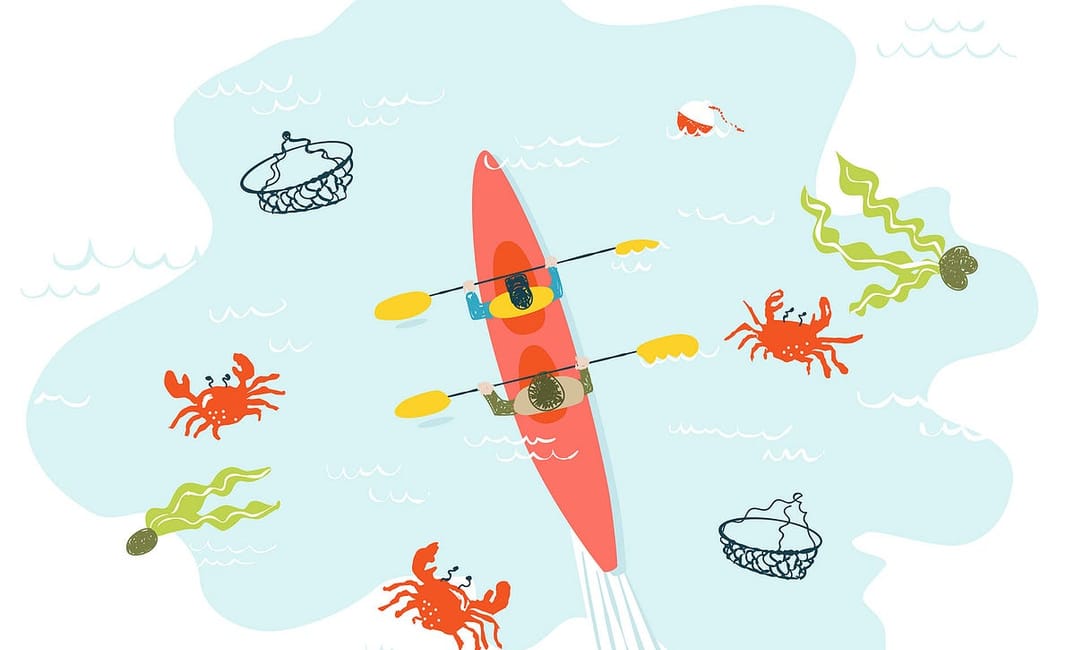
M y hand skims the water and grabs the blue noodle. It’s the fourth in a line of five buoys floating on the surface of the Pacific Ocean 70 miles north of San Francisco in Bodega Bay. It’s not the buoy I’m after, but what it’s attached to: 30 feet of rope and a crab pot that’s been soaking on the ocean floor for the past 15 minutes. The pot, or ring net, is fitted with a small cage packed with 40-cents-a-pound raw chicken we’re using as bait. I give the rope a good tug, and judging by the resistance, I can already tell I’ve got crab on.
I do what I’ve been told to do and check the net for rays, urchins and other spiny sea critters before planting it on the deck of my vessel (a 10-foot plastic ocean kayak) a few inches from my naked feet. When devoid of such perils, the net is full of crab.
I take a quick inventory.
One rock crab (Romaleon antennarium), two reds (Cancer productus) and four Dungeness (Metacarcinus magister) — the largest crab species common to these waters and the one we’re up here to catch. Of the Dungeness, two are potential keepers, and two are still juveniles. I’ll have to measure the adults to determine if they meet the five-and-three-quarters-of-an-inch regulation, but before I can do that, I’ll need to clear the net of the others.
The juvies are the first to go. Godspeed, little imps. May you grow big and strong, make babies and, with a little luck, escape the steamer.
The red crabs are next. With shells of deep, speckled crimson and oversize black-tipped pincers, they are the visual specimens of the bunch. The reds go with relative ease. This is not the case with the rock crab, whose kin I’ve been at war with all morning.
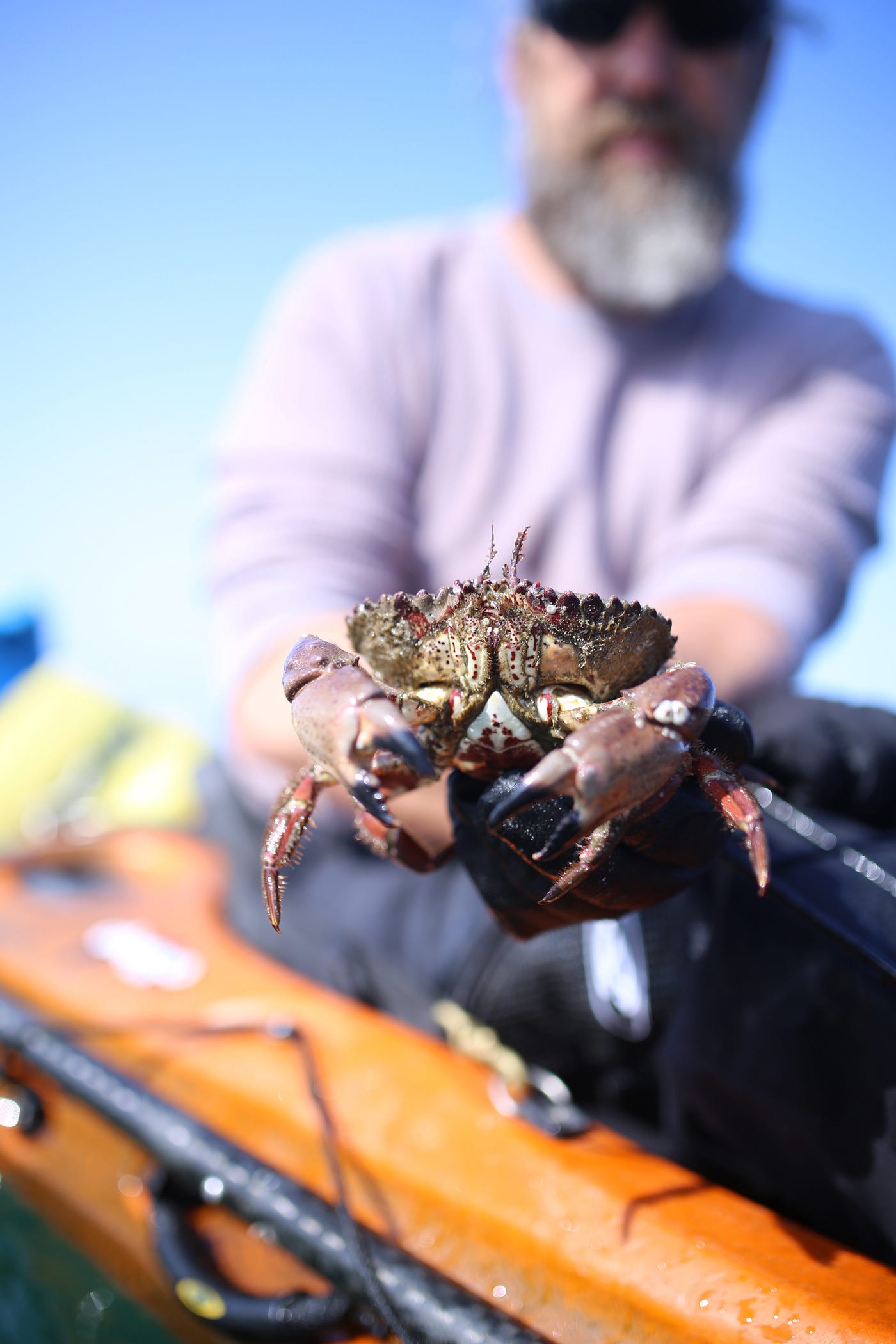
The smallest of the three species, but with the largest pincers proportionally, the rock crab is a tough draw for any weight class. I approach from behind, aiming for the base of the shell and hind legs, as I’ve been taught to do. Sensing my presence, the bugger scurries around to meet me head on, its claws outstretched in fighting posture and its jaws twitching in the form of a strange geometry.
It’s enough to make this grown man shiver.
I improvise what seems like a reasonable solution: I grab the metal rim of the net and shake. My gambit works. The rock crab has flopped back around while my Dungeness have stayed put. I reach back in and take hold of the crab’s abdomen. But when I go to lift him out, the pincers clamp down on the pot netting and refuse to let go.
More shaking. More failed excavations. Our clumsy dance ends with a claw attached to the middle fingertip of my fishing glove, thankfully a size too big, and me flailing my hand over the side of my kayak until, at last, the crustacean relents.
As I watch my nemesis twirl and sink into the inky abyss, I have a chance to experience that slow wonder that keeps bringing me back to nature season after season. Thoughts rattle off one after another: Crabs live in the ocean but can’t swim. How do they breathe? What do they remember?

T he moment is short lived. I need to get back to my net and the Dungeness. The female — identified by the round tail flap on her plated underbelly — is the keeper of the two. The sunlight reflects a mauve hue off the top of her brown shell, on which a prehistoric mollusk known as a chiton has adhered itself. I place my catch, stowaway and all, in the bow well of my kayak and paddle on.

The fifth and final pot on the line is empty, save for a lone rock crab. I flip it out of the net with surprising efficiency and head back to the shore to rendezvous with Spike, my guide for the morning, back at the beach.
It’s not even 10:00 a.m., and if nothing eventful were to happen for the rest of the day, I’d still feel pretty accomplished. I have my crab and a view of the Pacific all the way to the bowed horizon in the west.
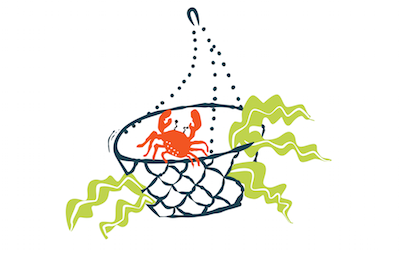
Ifirst met Dennis Spike on Christmas Eve of 2014. My wife’s brothers and I were preserving a holiday fishing tradition during which, in addition to engaging in family bonding, the goal is to avoid a visit to the local fishmonger with our tails between our legs on our way home to hungry, festive family members. Our trip with Spike did not disappoint. The three of us returned with more than 20 crabs, plus a good-size rock cod Spike had caught with his spinning reel near the jetties by the beach.
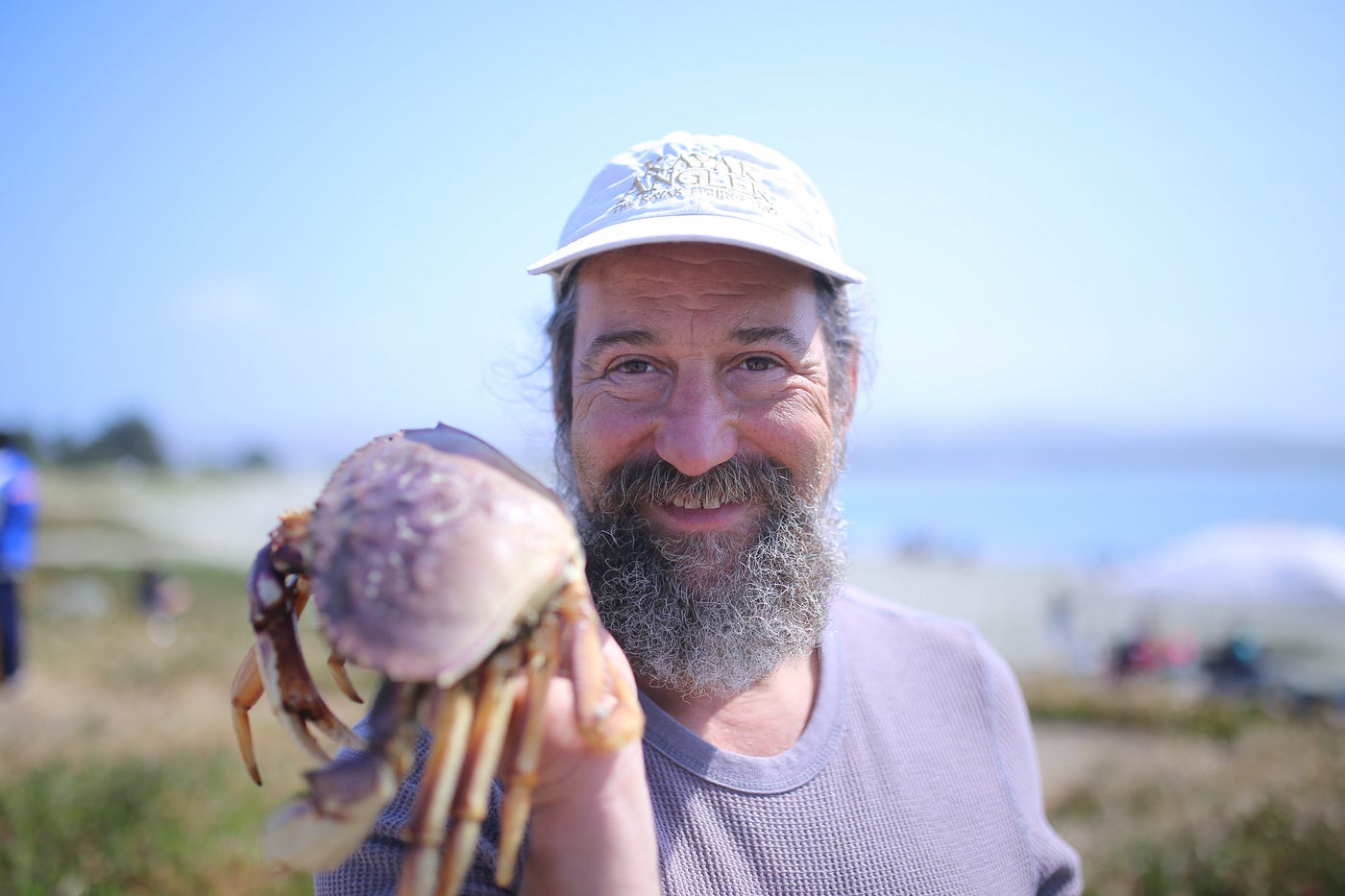
There are few things in life as satiating as fresh-out-of-water seafood prepared simply. The sweet, tender meat of Dungeness crab is no exception, and the sleepy euphoria of having eaten altogether too much shellfish was a welcome reward for spending three hours on choppy ocean waters in the middle of the winter.
Today’s experience is a little different. It’s May, not December, and the air at 8:00 a.m. is already a balmy 64 degrees. The bay itself is still and shimmering with light.
I meet Spike at Doran Beach on the tip of the small peninsula of Doran Regional Park that’s home to a diverse collection of shorebirds, flora and ocean life. With his long, ashy beard and scratchy baritone, Spike has the requisite saltiness we’ve come to expect from men who make their living harvesting the sea. But talk to the man for a few minutes, and it’s clear his code is that of a naturalist who believes that low-impact, sustainable practices are the key to our fisheries’ health and our own.
Kayaks, for starters, don’t burn fuel, threaten our coastlines with the need for docks and marinas, or lacerate marine mammals with their propellers. They do give us exercise and bring us closer to the natural world.
“You don’t see many kayakers paying for a whale watch or a trip to the aquarium,” Spike tells me later. “Whales, bat rays, rare dolphins, jellyfish: it’s all right here.”
In addition to crabbing, Spike guides fishing trips 20 miles north out of Fort Ross for rock fish, lingcod, halibut and the occasional salmon or thresher shark. He prides himself on forgoing the big trophy fish, which have had more time to accumulate heavy metal toxins like mercury and better serve the ecosystem by spawning, for the cleaner ones.
Like most fishing guides I’ve met, Spike is also a gifted orator.
“Every crab fisherman has his own BS theory for how to catch crab, and here’s mine. I’d say it’s worked out pretty good so far,” Spike says, and launches into a rundown of our gear, bait and method of dropping the pots 20 feet apart in a line along the edge of a current. Once we set the line, we’ll explore the bay in our kayaks awhile, check and reset the pots, and repeat until we reach our limit of crab or kayaking. As insurance, we’ll also check the boxy cage traps that Spike has been soaking overnight. He’s trying an experimental new bait—strictly off the record—and wants to see how it works out.

Spike has added extra netting to our bait cages using upcycled oyster bags because the sea lions — or the dogs of the sea, as he calls them — have developed a taste for raw chicken in recent years. “It took a while, but now it’s a couple of bad generations already,” he laments. The upside is that pups will sometimes tag along with the kayaks.
After a quick paddling lesson, we hit the water. In these conditions, the kayaks fly atop the surface, and before we know it, we’re out far enough to start dropping pots. I haven’t seen any dogs but can hear their barks echo from Bodega Rock, a tiny granite island a half mile farther out where sea lions and harbor seals congregate to sunbathe and convalesce. All the arfing reminds me that sharks like to eat these things and that Bodega marks the northern tip of the Red Triangle, home to one of the densest populations of great whites in the world. Over 50 percent of all recorded attacks by white sharks on humans have occurred in this region.
“What about sharks?” I ask Spike.
“Oh, here, we’re fine,” he says. “On the other side of that rock, it’s a cafeteria.”
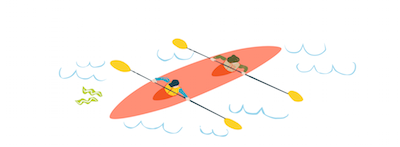
Spike had just finished acupuncture school in Los Angeles when he tried fishing from a kayak for the first time on a hunch and was immediately hooked. He went from fishing maybe 20 times on a good year to over 100.
“Lots of people consider themselves anglers who go on a few trips a year. But once you get into a kayak, it opens it up to a daily pursuit,” Spikes says. “It takes the hobby out of fishing and turns it into a lifestyle — one that surrounds you with nature and builds community. It becomes a family activity instead of a disruption to family life.”

Spike’s passion for the pastime led him to write, in 1995, the first national magazine feature on kayak fishing for Pacific Fisherman and reconsider his career path. He started kayakfishing.com, the first website dedicated to kayak angling, and shifted focus to his guiding business. After stints in the Sea of Cortez and Malibu, Spike settled in Bodega Bay, where his partner (also a angler) had roots. In Bodega, Spike found the natural fishery he’d been looking for and like-minded clientele seeking a unique outdoor experience.
The Northern California waters have proved so bountiful that Spike hopes to one day expand his business to include commercial fishing, with the goal of supplying kayak-caught seafood to local markets and restaurants. He plans to incorporate his knowledge of acupuncture and eastern medicine to promote what he calls “the Chi of wild and organic seafood.”
The fishing business is not without its challenges, however. This year, for example, the start of crab season was delayed by four months due to unsafe levels of domoic acid found in crabs throughout the West Coast. When consumed by humans, domoic acid acts as a neurotoxin and can cause dizziness, vomiting, seizures, coma or even death. The root problem: a massive algal bloom created by unusually warm waters. The algae congregate on the surface in what’s known as a red tide, sucking up oxygen as they decay and producing domoic acid. Eventually, the sediment dusts the ocean floor and contaminates the food chain.
By the time the season opened in late April, the best crabbing, typically done in November and December before the females molt and head to shore to mate, had long since passed. The delay has cost California fisherman an estimated $68 million dollars, prompting Governor Jerry Brown to lobby for federal disaster relief, and could be the reason I’ve measured only one legal crab all morning.
Still, Spike maintains a healthy perspective.
“Fishing is a seasonal thing,” he says. “We’re at the mercy of nature. It’s just part of the deal. Like any guide, I do about nine different things to make it work.” For now, it’s crabbing until the end of June and then fishing through the end of the year.
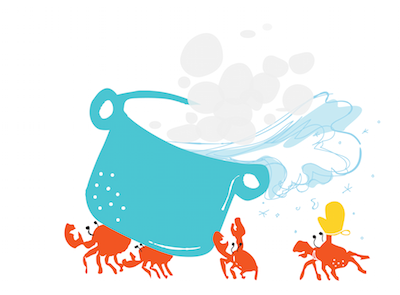
Back at the beach, I discover the real reason I’ve brought back only one keeper. When Spike holds up his gauge to check the size of my female, I realize I’d been using mine incorrectly. It’s one thing to see it demonstrated and another to do it yourself in a wobbly boat with five pairs of protesting claws. There must have been three to four more legal-size Dungeness in those nets.
Despite the blunder, I can’t help but feel a little happy for the ones that got away. Plus, a single adult Dungeness is enough to feed one or two people on its own, and Spike has a few extra for me that he pulled from his traps with the new bait.
I tell Spike about the locals we met on the water, the ones out there catching their dinner, treating a paddle on the bay like just another trip to the grocery store—a really, really beautiful grocery store.
“Well, we’re all out here trying to catch our dinners,” he replies. At this point, I’m not sure if he’s speaking literally or about some greater truth — a common theme in my conversations with Spike. But at the end of the day, he reminds me, it’s all about access. Access to nature. Access to sport. Access to fresh seafood. All without having to spend a fortune. The kayaks can be found for cheap on Craigslist, the bait is under a buck a pound, and the scenery is free.
Illustrations by Julia Barzizza. Photos by Zach Winter.



